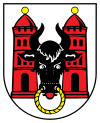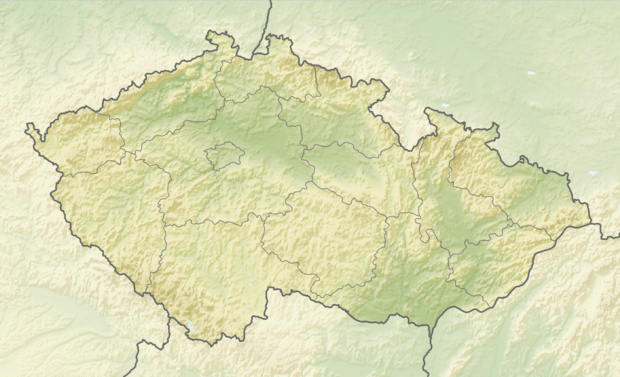Přerov
Přerov (Czech pronunciation: [ˈpr̝̊ɛrof]; German: Prerau) is a city on the Bečva River in the Olomouc Region of the Czech Republic. It has a population of approximately 43,000 people. Přerov is about 22 kilometres (14 miles) south east of Olomouc. In the past it was a major crossroad in the heart of Moravia in the Czech Republic.
Přerov | |
|---|---|
.jpg) Upper Square in Přerov | |
 Flag  Coat of arms | |
 Přerov Location in the Czech Republic | |
| Coordinates: 49°27′20″N 17°27′4″E | |
| Country | |
| Region | Olomouc |
| District | Přerov |
| First mentioned | 1141 |
| Government | |
| • Mayor | Petr Měřínský (ANO) |
| Area | |
| • Total | 58.50 km2 (22.59 sq mi) |
| Elevation | 210 m (690 ft) |
| Population (2020-01-01[1]) | |
| • Total | 42,871 |
| • Density | 730/km2 (1,900/sq mi) |
| Time zone | UTC+1 (CET) |
| • Summer (DST) | UTC+2 (CEST) |
| Postal code | 750 02 |
| Website | www.prerov.eu |
Administrative parts
Villages Předmostí, Lověšice, Kozlovice, Dluhonice, Újezdec, Čekyně, Henčlov, Lýsky, Popovice, Vinary, Žeravice and Penčice are administrative parts of Přerov.
History
Settlement in the locality dates back to prehistoric times. There is a world—renowned prehistoric site from the stone age on the mound called Hradisko in Přerov Předmostí. The oldest written reference to Přerov dates to 1141 when bishop Jindřich Zdík mentioned Přerov's church of St. George as one of the most important ones in Moravia. King Ottokar II of Bohemia gave Přerov the privilege of being a royal town in 1256. The mansion of Přerov, built in place of the former castle, was a residence of an influential house, the house of Pernštejn and Žerotín, from which Charles the Elder of Žerotín significantly influenced the town. Přerov also plays an important role in history of the Czech protestant church known as Unity of the Brethren.
The town grew the most in 19th century after a railway line was built through it first from Vienna to Olomouc, later extended to Prague.
In June 1945, during the expulsion of Germans from Czechoslovakia, 71 men, 120 women and 74 children were killed in an illegal massacre of the German population.[2]
German terror in Bohemia and Moravia peaked in Spring 1945 sparking a Czech uprising, which started in Přerov on May 1 and then spread throughout the whole country after the murder of 78,154 Czech Jews and 340,000 Czech citizens during the German occupation.[3]
Present
Today the main commercial heart of the city lies around the T.G. Masaryk Square, which is of limited architectural interest. Of greater interest is the cobbled Upper Square enclosed by historic buildings, where the Comenius Museum can be found. Currently, Přerov is the social, administrative and cultural centre of the district with developing economics.
Transport
The city is a major railway junction with mainlines to Prague via Olomouc, Warsaw via Ostrava, and Vienna via Břeclav, and a regional line to Brno. The helicopter air force is based in Přerov.
Education
In Přerov there is a College of logistics, an affiliate of Tomas Bata University in Zlín.
Sport
Notable people
- Jan Blahoslav (1523–1571), developer of Czech grammar
- John Comenius (1592–1670), pedagogue and theologian, the father of modern education, taught at Přerov Latin school in 1614–18, having earlier studied there
- Franz Petrasch (1744–1820) Austrian general in the Habsburg military during the French Revolutionary Wars
- Abraham Placzek(1799–1884), chief rabbi of Moravia in 1847–1851
- Rudolf Weigl (1883–1957), biologist
- Liane Zimbler (1892–1987), architect
- Karel Janoušek (1893–1971), senior Czechoslovak Air Force officer
- Ida Ehre (1900–1989), actor and theatre director and manager
- Edouard Borovansky (1902–1959), ballet dancer
- Vilém Tauský (1910–2004), conductor and composer
- Eliška Kleinová (1912–1999), pianist and music educator
- Josef Kainar (1917–1971), poet
- Gideon Klein (1919–1945), composer and pianist
- Jiřina Hauková (1919–2005), poet and translator
- František Šolc (1920–1996), French hornist and horn teacher
- Pavel Novák (1944–2009), singer and musician
- Pavel Hobza (born 1946), scientist in the field of computational chemistry
- Vladimír Hučín (born 1952), political prisoner, secret service agent, honorary citizen of Přerov
- Karel Plíhal (born 1958), singer and musician
- Ctislav Doseděl (born 1970), tennis player
- Petr Ruman (born 1976), footballer
- Tomáš Cigánek (born 1978), footballer
- Jani Galik (born 1984), footballer
- Josef Hrabal (born 1985), ice hockey player
- Tomáš Kundrátek (born 1989), ice hockey player
- Kateřina Sokolová (born 1989), Miss World contestant
Twin towns – sister cities







References
- "Population of Municipalities – 1 January 2020". Czech Statistical Office. 2020-04-30.
- Prausser, Steffen; Rees, Arfon (December 2004). "The Expulsion of the 'German' Communities at the End of the Second World War, page 18" (PDF). Department of History and Civilization. European University Institute, Florence. Archived from the original (PDF) on 2009-10-01. Retrieved 2008-12-08.
- Bažant, Jan; Bažantová, Nina; Starn, Frances (2010-12-13). The Czech Reader: History, Culture, Politics. Duke University Press. ISBN 0822347946.
- "Zubr Cup 2014 – Přerov" (in Czech). 21 June 2014. Archived from the original on 2014-11-09. Retrieved 9 November 2014.
- (in Czech)
- "Partnerská města - město Přerov" (in Czech). Město Přerov. Retrieved 2020-06-22.
External links
- Municipal website (cz)
- Prerovan.cz - Information portal for the district of Přerov (cz)
- another Přerov Website
- Comenius Museum in Přerov